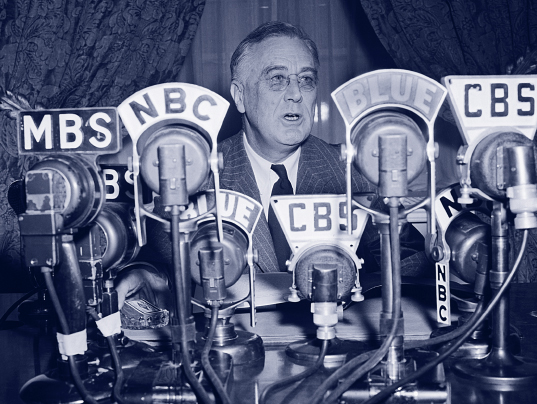The Golden Age of Radio
Printed Page 174
From the late 1920s to the 1940s, radio basked in a golden age marked by a proliferation of informative and entertaining programs (such as weather forecasts, farm reports, news, music, dramas, quiz shows, and comedies). This diversity of programming shaped—and was shaped by—American culture. It also paved the way for programs that Americans would later enjoy on television, as NBC, CBS, and ABC created television networks in the late 1940s and 1950s.
Early Radio Programming

In the early days of radio, only a handful of stations operated in most large radio markets. Through the networks they were affiliated with, these stations broadcast a variety of programs into listeners’ homes (and in some cases, into their cars). People had favorite evening programs, usually fifteen minutes long. After dinner, families gathered around the radio to hear comedies, dramas, public service announcements, and more. Popular programs included Amos ’n’ Andy (a serial situation comedy), The Shadow (a mystery drama), The Lone Ranger (a Western), The Green Hornet (a crime drama), and Fibber McGee and Molly (a comedy), as well as the “fireside chats” regularly presented by President Franklin Roosevelt.
Variety shows featuring musical performances and comedy skits planted the seeds for popular TV variety shows that would come later, such as the Ed Sullivan Show. Quiz shows (including The Old Time Spelling Bee) introduced Americans to the thrill of competition. These radio programs set the stage for later competition-based TV shows ranging from The Price Is Right and Who Wants to Be a Millionaire to reality-based shows such as Survivor, Fear Factor, Project Runway, and Top Chef.
Dramatic programs, mostly radio plays broadcast live from theaters, would later inspire TV dramas, including “soap operas.” (The term came into use after Colgate-Palmolive began selling its soap products on dramas it sponsored.) Another type of program—the serial show—introduced the idea of continuing story lines from one day to the next. This format was soon copied by soap operas and some comedy programs.
Radio as Cultural Mirror
Radio programs powerfully reflected shifts in American culture, including attitudes about race and levels of tolerance for stereotypes. For example, the situation comedy Amos ’n’ Andy was based on the conventions of the nineteenth-century minstrel show and featured black characters stereotyped as shiftless and stupid. Created as a blackface stage act by two white comedians, Charles Correll and Freeman Gosden, the program was criticized as racist by some at the time. But NBC and the program’s producers claimed that Amos ’n’ Andy was as popular among black audiences as among white listeners.4
Early radio research estimated that the program aired in more than half of all radio homes in the nation during the 1930–31 season, making it the most popular radio series in history. In 1951, Amos ’n’ Andy made a brief transition to television, after Correll and Gosden sold the rights to CBS for $1 million. It became the first TV series to have an all-black cast. But amid a strengthening Civil Rights movement and a formal protest by the National Association for the Advancement of Colored People (NAACP), which argued that “every character is either a clown or a crook,” CBS canceled the program in 1953.5

The Authority of Radio
In addition to reflecting evolving cultural beliefs, radio increasingly shaped them—in part by being perceived by listeners as the voice of authority. The adaptation of science-fiction author H. G. Wells’s War of the Worlds (1898) on the radio series Mercury Theatre on the Air provides the most notable example of this. Considered the most famous single radio broadcast of all time, War of the Worlds was produced and hosted by Orson Welles, who also narrated it. On Halloween eve in 1938, the twenty-three-year-old Welles aired the Martian invasion story in the style of a contemporary radio news bulletin. For people who missed the opening disclaimer, the program sounded like an authentic news report, with apparently eyewitness accounts of battles between Martian invaders and the U.S. Army.
The program triggered a panic among some listeners. In New Jersey, some people walked through the streets with wet towels wrapped around their heads for protection against deadly Martian heat rays. In New York, young men reported to their National Guard headquarters to prepare for battle. Across the nation, calls from terrified citizens jammed police switchboards. The FCC called for stricter warnings both before and during programs imitating the style of radio news.